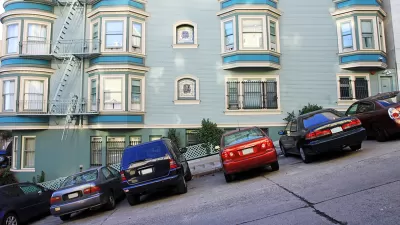The search for an available parking space in most busy downtowns can be frustrating, especially when the motorist insists on parking for free. For those cities that do charge for parking, can a variable price free-up spaces? SF hopes to prove so.
Two NYT reporters, Michael Cooper and Jo Craven McGinty provide a timely update on SF Park - a federally subsidized program that utilizes embedded sensors in on-street parking spaces to detect when a vacancy occurs and varies meter prices based on time of day and location. One main objective of the plan is to utilize pricing (often referred to as dynamic or performance pricing) and technology to reduce traffic congestion caused by motorists searching for available on-street parking.
"The program here is being closely watched by cities around the country. With the help of a federal grant, San Francisco installed parking sensors and new meters at roughly a quarter of its 26,800 metered spots to track when and where cars are parked. It is too early to tell whether the program is working over all, but an analysis of city parking data by The New York Times found signs that the new rates are having the desired effect in some areas."
However, the reporters also found that "about a fifth of the time" parking availability did not always correspond with prices, i.e. sometimes parking availability would increase with decreased prices and would decrease when prices were lowered.
"The program is the biggest test yet of the theories of Donald Shoup, a professor of urban planning at the University of California, Los Angeles. "I think the basic idea is that we will see a lot of benefits if we get the price of curbside parking right, which is the lowest price a city can charge and still have one or two vacant spaces available on every block," he said.
Thanks to Mayer Horn
FULL STORY: A Meter So Expensive, It Creates Parking Spots

Study: Maui’s Plan to Convert Vacation Rentals to Long-Term Housing Could Cause Nearly $1 Billion Economic Loss
The plan would reduce visitor accommodation by 25,% resulting in 1,900 jobs lost.

Alabama: Trump Terminates Settlements for Black Communities Harmed By Raw Sewage
Trump deemed the landmark civil rights agreement “illegal DEI and environmental justice policy.”

North Texas Transit Leaders Tout Benefits of TOD for Growing Region
At a summit focused on transit-oriented development, policymakers discussed how North Texas’ expanded light rail system can serve as a tool for economic growth.

Paris Bike Boom Leads to Steep Drop in Air Pollution
The French city’s air quality has improved dramatically in the past 20 years, coinciding with a growth in cycling.

Why Housing Costs More to Build in California Than in Texas
Hard costs like labor and materials combined with ‘soft’ costs such as permitting make building in the San Francisco Bay Area almost three times as costly as in Texas cities.

San Diego County Sees a Rise in Urban Coyotes
San Diego County experiences a rise in urban coyotes, as sightings become prevalent throughout its urban neighbourhoods and surrounding areas.
Urban Design for Planners 1: Software Tools
This six-course series explores essential urban design concepts using open source software and equips planners with the tools they need to participate fully in the urban design process.
Planning for Universal Design
Learn the tools for implementing Universal Design in planning regulations.
Smith Gee Studio
Alamo Area Metropolitan Planning Organization
City of Santa Clarita
Institute for Housing and Urban Development Studies (IHS)
City of Grandview
Harvard GSD Executive Education
Toledo-Lucas County Plan Commissions
Salt Lake City
NYU Wagner Graduate School of Public Service



























